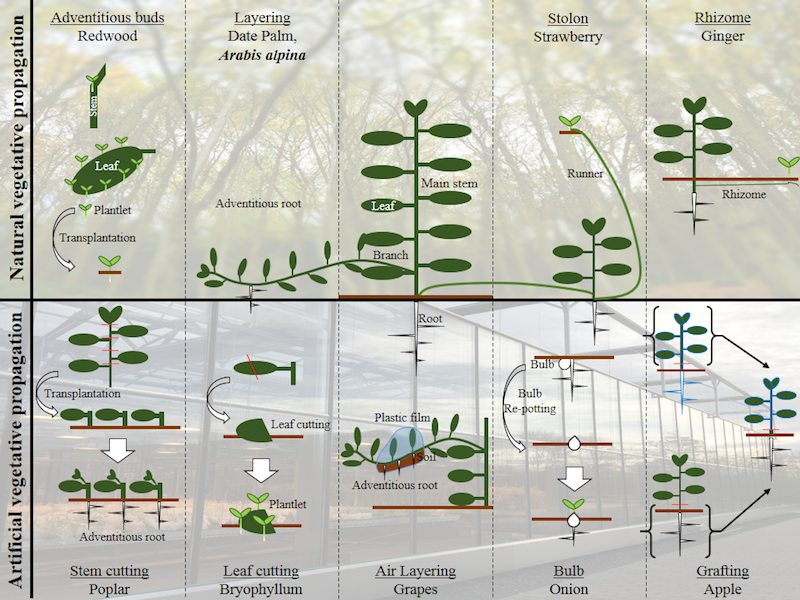Clones to our rescue! – An introduction to vegetative propagation in plants
Perennial plants have the ability to maintain vegetative growth after flowering and live for many years. Vegetative reproduction is a trait most common in perennial species. It facilitates the growth of a new plant from a vegetative organ such as stem, root or leaf. Thus, it provides an alternative to increase reproductive success post injury or under harsh environments, when seed production becomes unreliable. Small herbaceous perennial plants can actively clonally propagate through specialized structures as shown in the figure.
In the plant breeding industry, vegetative reproduction has been used to achieve rapid fixation of elite genotypes and omit the long phase of juvenile growth in perennial plants. The production of adventitious roots on stem cuttings is one of the ways to clonally propagate. However, the molecular mechanisms regulating adventitious rooting are not yet understood.
Within CEPLAS, we aim to comprehend the regulation of molecular mechanisms leading to adventitious rooting using Arabis alpina as a model. A. alpina is an alpine perennial. Although, it sexually reproduces through seeds, it can clonally propagate through adventitious roots on creeping stems. Thus, A. alpina makes the perfect model to understand the adaptive impact of adventitious rooting during clonal growth in perennials.
Figure legend
Vegetative propagation in plants
The common way plants propagate in nature (top panel) and the techniques exploiting vegetative propagation in plants in agricultural industries (bottom panel) are shown in the figure. A plant and its parts are depicted in the center of the top panel with roots extending into the bottom panel. The propagation methods are separated with dotted lines into sections. The methods are labelled on the top (top panel) and bottom (bottom panel) with examples. The soil is represented in brown. The curved arrow represents transplantation of respective plant parts to soil. The white down arrows depicts change in time. Cuts are represented as red lines. Plantlets are depicted as having cotyledons on hypocotyl.
Natural vegetative propagation
In the Redwood (Sequoia sempervirens) plant, adventitious buds are formed when the trunk is exposed to sunlight. These buds can develop into plantlets and gradually mature. Bryophyllum daigremontianum produces plantlets on the margin of the leaves. These plantlets fall to the ground when they increase in size and develop into individual plants. The creeping branches of Arabis alpina produce adventitious roots on the branches. The branch when separated from the mother plant will keep growing with the adventitious roots as support. Strawberry plants develop horizontal braches growing near the soil which produce adventitious buds. Rhizomes are a way of propagation in ginger. Rhizomes are horizontal underground stems and can produce adventitious buds.
Artificial vegetative propagation
Poplar stems can be cut into many pieces. The stem cuttings have the ability to root and produce adventitious buds that form new plants. Bryophyllum plants can be propagated using the plantlets produced on the leaf margin. Air layering is a technique based on layering in Arabis alpina producing adventitious roots to make clones. The branches are wrapped with wet soil or cloth covered with a plastic film to trap the moisture and nutrients. Plants like onion and orchids produce bulbs. Bulbs are modified stem with fleshy leaves. Grafting can also be used for vegetative propagation. In grafting, plant parts with desired features are joined and let to mature. This technique is often used in fruit cultivation.
Contribution by Priyanka Mishra, Max Planck Institute for Plant Breeding Research Cologne
Planter’s Punch
Under the heading Planter’s Punch we present each month one special aspect of the CEPLAS research programme. All contributions are prepared by our young researchers.
Corresponding publication
Wang R., Farrona S., Vincent C., Joecker A., Schoof H., Turck F., Alonso-Blanco C., Coupland G. and Albani M. C. (2009) PEP1 regulates perennial flowering in Arabis alpina. Nature 459: 7245: 423-427. [Abstract]
